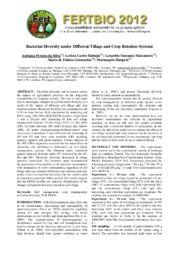Bacterial diversity under different tillage and crop rotation systems.
Bacterial diversity under different tillage and crop rotation systems.
Autoria: SILVA, A. P.; BABUJIA, L. C.; MATSUMOTO, L. S.; GUIMARÃES, M. de F.; HUNGRIA, M.
Resumo: Microbial diversity can be used to assess the impact of agricultural practices on the long-term sustainability of cropping systems. The aim of this study was to investigate changes in soil bacterial diversity as a result of the impact of different soil tillage and crop rotation systems. Bacterial diversity was examined in the 0-10 cm layer in two field experiments by analyzing soil DNA using 16S rDNA PCR-DGGE profiles. Experiment 1 was a 26-year trial consisting of four soil tillage management systems: (1) no-tillage (NT), (2) disc plow (DP), (3) field cultivator (FC) and (4) heavy-disc harrow (DH), all under soybean(summer)/wheat(winter) crop succession. Experiment 2 was a 10-year trial consisting of DP and NT and three crop rotations (CR) including grasses, legumes and green manures. Cluster analysis of the 16S rDNA sequences revealed that the main effect on clustering was attributed to differences in soil tillage management systems. The Shannon index confirmed greater bacterial diversity under NT, followed by the FC, DH and DP. Therefore, diversity decreased as tillage practices intensified. The evenness index demonstrated the uniformity of the profiles of the bacterial communities with dominance of a few communities, regardless of soil tillage and crop rotation. Different crop rotations had only minor effects on bacterial diversity, but the results could be related to a previous fallow period. The results suggest that the DGGE profiles are sensitive bioindicators of the changes in bacterial diversity caused by soil tillage.
Ano de publicação: 2012
Tipo de publicação: Artigo em anais e proceedings
Unidade: Embrapa Soja
Palavras-chave: Crop rotation, Rotação de cultura, Sistema de cultivo
Observações
1 - Por padrão são exibidas publicações dos últimos 20 anos. Para encontrar publicações mais antigas, configure o filtro ano de publicação, colocando o ano a partir do qual você deseja encontrar publicações. O filtro está na coluna da esquerda na busca acima.
2 - Para ler algumas publicações da Embrapa (apenas as que estão em formato ePub), é necessário ter, no celular ou computador, um desses softwares gratuitos. Sistemas Android: Google Play Livros; IOS: iBooks; Windows e Linux: software Calibre.
Acesse outras publicações
Acesse a Base de Dados da Pesquisa Agropecuária (BDPA) para consultar o acervo completo das bibliotecas da Embrapa.

